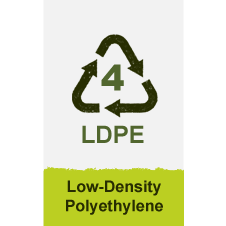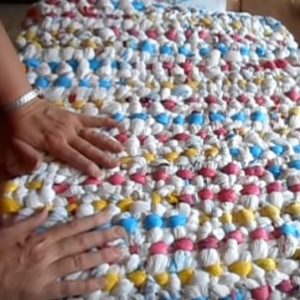Like HDPE, LDPE belongs to the polyethylene (PE) group, This is the flexible version of polyethylene plastic, hence the ‘low density’ in the name.
 Recycling
Recycling
Due to the lightweight nature of the material, in countries such as the UK, it isn’t usually cost effective to collect it from the kerbside and transport it to the recycler. Other difficulties include: it is often not labeled, it’s too light and tends to be more difficult to clean. Fortunately, most large supermarkets now have carrier bag bins where you can drop off any LDPE for recycling. It will typically go on to become a new carrier bag or film.
A popular recycling technique for plastic bags is ironing them into a more durable textile.
 Properties
Properties
- At room temperature it is not reactive
- Chemically inert
- It is quite flexible and tough
- Insulating
PROS:
- Chemical and hydrolysis resistance
- High impact strength (low temp)
CONS:
- Low tensile strength
- Low stiffness
- Low max temp
- Burns easily
- Poor UV resistance
- High mold shrinkage
- It breaks down more easily than other plastics
- When exposed to consistent sunlight, the plastic produces significant amounts of two greenhouse gases: methane and ethylene
How can I tell if something is made of LDPE? See CIWM/WasteAid guide
1. Look: LDPE is soft and flexible (it is usually used as a film). It is translucent (lets light through but is not clear), and softens at 70˚C. It often has a 4 embossed on it.
2. Feel: LDPE feels soft, smooth and flexible. It can be scratched easily with a fingernail.
3. Listen: If you rub it together, it will make a soft swishing sound, as opposed to a crinkling, harsher sound.
4. Float test: LDPE floats in water.
5. Flame test:
- Blue, yellow tipped flame
- Burns slowly
- Plastic drips
- Smells like candle wax (paraffin).
 WARNING
WARNING
LDPE itself (when not burning) is not dangerous to use, however additives can be dangerous. It’s not possible to see what kind of additives are used in products.
Sources


 Recycling
Recycling Properties
Properties WARNING
WARNING






